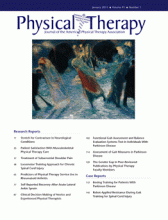Abstract
Background Contractures are a disabling complication of neurological conditions that are commonly managed with stretch.
Objective The purpose of this systematic review was to determine the effectiveness of stretch for the treatment and prevention of contractures. The review is part of a more-detailed Cochrane review. Only the results of the studies including patients with neurological conditions are reported here.
Data Sources Electronic searches were conducted in June 2010 in the following computerized databases: Cochrane CENTRAL Register of Controlled Trials, Database of Abstracts of Reviews of Effects (DARE), Health Technology Assessment Database (HTA), MEDLINE, Cumulative Index to Nursing and Allied Health Literature (CINAHL), EMBASE, SCI-EXPANDED, and Physiotherapy Evidence Database (PEDro).
Study Eligibility Criteria The review included randomized controlled trials and controlled clinical trials of stretch applied for the purposes of treating or preventing contractures in people with neurological conditions.
Study Appraisal and Synthesis Methods Two reviewers independently selected studies, extracted data, and assessed risk of bias. The primary outcome measures were joint mobility (range of motion) and quality of life. Secondary outcome measures were pain, spasticity, activity limitation, and participation restriction. Meta-analyses were conducted using random-effects models.
Results Twenty-five studies met the inclusion criteria. These studies provide moderate-quality evidence that stretch has a small immediate effect on joint mobility (mean difference=3°, 95% confidence interval [CI]=0° to 5°) and high-quality evidence that stretch has little or no short-term or long-term effects on joint mobility (mean difference=1° and 0°, respectively, 95% CI=0° to 3° and −2° to 2°, respectively). There is little or no effect of stretch on pain, spasticity, and activity limitation.
Limitations No studies were retrieved that investigated the effects of stretch for longer than 6 months.
Conclusion Regular stretch does not produce clinically important changes in joint mobility, pain, spasticity, or activity limitation in people with neurological conditions.
Footnotes
All authors provided concept/idea/research design, writing, and data collection and analysis. Mr Katalinic and Associate Professor Harvey provided project management and consultation (including review of manuscript before submission). Associate Professor Harvey provided facilities/equipment and institutional liaisons. The authors acknowledge the contributions of Anne Moseley, Natasha Lannin, and Karl Schurr as coauthors of the Cochrane review. They also acknowledge the assistance of Joanne Glinsky in preparing the manuscript.
This is a version of a Cochrane review, which is available in The Cochrane Library, 2010, issue 9 (see www.thecochranelibrary.com for information). A more-detailed review is published and updated in the Cochrane Database of Systematic Reviews. 19 The results of a Cochrane review can be interpreted differently, depending on people's perspectives and circumstances. Please consider the conclusions presented carefully. They are the opinions of review authors and are not necessarily shared by The Cochrane Collaboration.
An oral presentation of this research was given at the Australian Physiotherapy Association Conference; October 1–5, 2009; Sydney, New South Wales, Australia.
- Received August 13, 2010.
- Accepted September 26, 2010.












